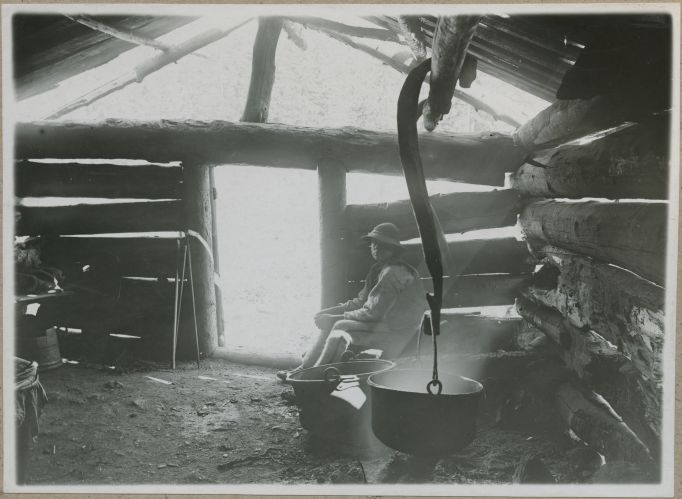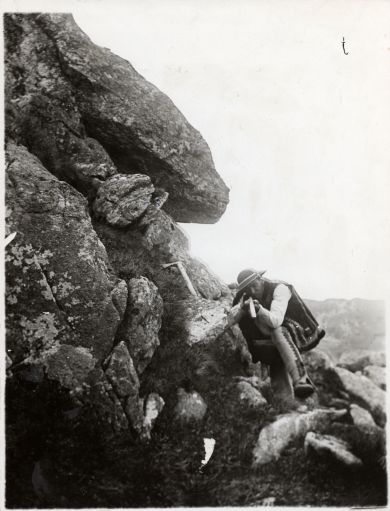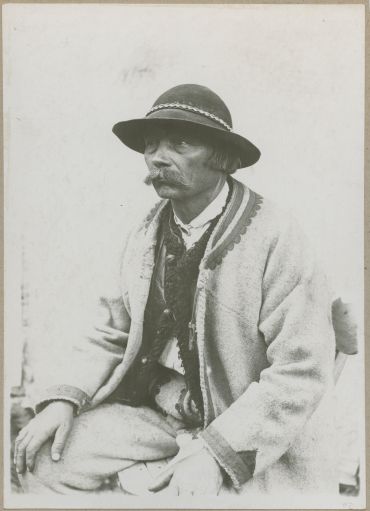‘A traveller steps off a cart and assesses a highlander as if he came from China and looked at a European. A highlander, as a person of impeccable manners, responds in a rather humorous vein.
– Ain’t the folks’ vest quite ugly? – he says pointing at his jacket covered with grease stains.’Stanisław Witkiewicz “On the Mountain Pass”

Walery Eliasz Radzikowski, Highlander in Alpine Tundra, III-7345-F-sygn-m-III-12192
Zakopane is considered one of the most popular tourist destinations in Poland alongside Warsaw, Krakow and Trójmiasto. Why has the small town situated at the foot of the Tatra Mountains gained such prominence as a cultural and recreational centre? Why does it attract a massive influx of tourists from all over the world? And why has photography played and continues to play a part in all this?
Podhale is a peculiar Polish region which, ever since the Middle Ages, had been invaded by settlers from Germany, Italy and Poland itself. Due to its location, it had gradually separated from the rest of the country and formed the Southern Borderlands. The highland folk art drew on the wide variety of national traditions and interpreted them differently from those residing in the central regions of the country.
The Podhale region was discovered around the nineteenth century initially by artists and scientists. The arrival of tourists and visitors, including photographers, ensued. The leading photographers worth mentioning include Walery Rzewuski, Walery Eliasz Radzikowski, Awit Szubert, Stanisław Bizański, Henryk Schabenbeck and Tadeusz Palczewski, some of whom established even their own makeshift studios in Zakopane or Szczawnica.
In the nineteenth century, a long and arduous journey to the Podhale finally ended with one coming face to face with ‘the Others’ – highlanders who looked and talked differently. What’s particularly fascinating is the fact that the people, whose behaviour the newcomers from the central regions of Poland found so aberrant, have ultimately been the ones who have preserved the national heritage and folklore in their indigenous culture. According to Maria Małanicz-Przybylska, ‘a highlander is an independent, carefree yet hardworking person with a strong sense of pride. A highlander is noble, cheerful and self-assured. The one who lives in the mountains possesses the features every single Polish person should have’. The article’s author ponders the question whether this kind of image of a highlander had been commonplace prior to the arrival of the travellers, scientists, writers and artists, who simply conjured it all up. Maria Małanicz-Przybylska calls the phenomenon ‘the Podhalanism‘, which instantly brings to mind the term ‘Orientalism’. Despite the obvious distinctions, one could draw parallels between the nineteenth century Podhale region and the colonies of the European countries.

Tadeusz Padlewski, Highlander with daughters, 1911, AFN 380 I.
One question remains: is the seemingly positive attitude towards highlanders genuine or is it patronizing and dubious? Does this attitude still manifest itself in contemporary culture?
I look for the answers in the photographs of the Podhale region taken prior to the WWI and divide them into the categories, such as ‘portrait’, ‘house’, ‘religion’ and ‘nature’. The photographs served various purposes: some of them are private pictures and others commercial, the latter of which were used in the then popular carte de visite or photobooks depicting the region. The majority of photographs show the stereotypical image of a highlander, namely a sturdy man with a beard who wears traditional clothing, including a puffy shirt, bright colourfully embroidered trousers, a jacket, as well as a hat decorated with shells. Furthermore, they often carry a pipe or a rifle.
A highlander’s house is often modest. It provides background for family portraits. Eliasz Radzikowski, however, took some photographs inside the ramshackle cottages, as well as of the shepherds’ shelters on the grazing. His typology seems exceptionally modern in comparison with more recent pictures.
Some photographs portray the manifestations of faith on the part of highlanders. Walery Rzewuski’s portrait entitled ‘Kazanie niedzielne’ (‘Sunday Sermon’) features several people reading the Bible, one of whom is Father Stolarczyk, the very first priest in charge of the parish in Zakopane. Whereas, Tadeusz Palczewski photographed wedding ceremonies and first communions. However, perhaps due to the lack of technology which would allow to capture dynamic scenes in constantly changing lighting, I came across very few photographs of this sort.
The Tatra Mountains are the essential component of the Podhale region’s landscape. In the photographs, a miniscule figure of a highlander can be discerned somewhere in the middle of a picture overtaken by the vast majestic mountains. Walery Eliasz Radzikowski’s archives are rife with the pictures of a highlander lost in thought, a highlander smoking a pipe, a highlander standing near the mountain range, a highlander sitting on a rock while raising his ciupaga (a walking stick with axe head).
Why did the image of the Podhale and the Polish highlander become so skewed, then? The nineteenth century passion for cataloguing and documenting various phenomena, which was studied by Edward Said, lead to the photography being used as the tool providing one with a clear and in-depth understanding of a world. Izydor Kopernicki, for instance, took dozens of the carte de visites photographs of highlanders in his own local studio. His models look indifferently into the camera while drawing our attention towards the details of their clothing. Stanisław Bizański adopted a similar approach. Nonetheless, his portraits were taken not only in his atelier, but also outdoors. Awit Szubert, Ignacy Kriger and Józef Eder, whose photographs are part of Ignacy Kopernicki’s collection, as well as Stanisław Bizański lay the foundations of the glorified image of the Polish highlander. Their collections of in fact unrelated photographs gave people the impression of representing the quintessence of a highlander. If one bothers to scrutinise the photographs, he or she would easily realise that they depict a homogenous group of people who wear the same outfit, who have a clear sense of common identity, who diverge from everything, which surrounds them.
The photographs are not, however, as detached from reality as one may think. On the contrary, they attempt to represent this reality accurately. The photographers may have simply believed that a staged picture captures the truth and real world much better due to their control over the attributes which were or weren’t highlighted.
Furthermore, according to Edward Said, the fact that the European culture was produced by and for the citizens of Europe exerted a considerable impact on the relations between European countries and their colonies. Flaubert, Camus and Conrad even penned their stories with Western society in mind. Europe’s world dominance triggered new opportunities ‘to be in far-flung places, to learn about other people, to codify and disseminate knowledge, to characterize, transport, install, and display instances of other cultures (through […] photographs).’ The process is blatantly one-sided. Natives had to remain silent.
Europe’s world dominance triggered new opportunities ‘to be in far-flung places, to learn about other people, to codify and disseminate knowledge, to characterize, transport, install, and display instances of other cultures (through […] photographs). The process is blatantly one-sided. Natives had to remain silent.
Antoni Krohl claims that the breakthrough occurred in the twentieth century when the persona of ‘the Master’ emerged. The Masters strived to appropriate the folklore of the Podhale region, to transform the local into the national, the poor into the rich. Their intention was to revitalise Poland and the Polish people’s mindset by reshaping highlanders’ simple lifestyle into something everyone should aspire to. The Podhale was supposed to initiate the rebirth of national heritage, which sounds ludicrous considering that the country’s territory extends mainly across the lowlands. The first photographers and authors of photobooks, which they circulated around the rest of the country, were members of the elite. As a result, the purported origin myth about the highlander came into existence although it had little to do with reality. The natives were completely excluded from the process. Instead, they played the role of guides or hosts, at the very best.
Following the line of argument put forward by Said, one could argue that colonialism does not only impose its dominance in the present, but it also projects itself into the future according to its own rules. In the nineteenth and twentieth century, the rules one should adhere to in order to be described as a true Polish highlander were formulated. Surprisingly enough, contemporary photography still follows these rules.

Walery Eliasz Radzikowski, Bothy on the Pyszna, III-40580-F-sygn-m-III-4344.
The photographs by Adam Brzoza born in Podhale, which were featured in the Polish edition of the National Geographic magazine, exemplify the abovementioned point. His photographs are the epitome of a stereotypical highlander, the exact copy of shots and motifs used by Walery Eliasz Radzikowski over a century ago. Thus, what we see in the pictures are traditional ceremonies, architecture, making of oscypek (smoked ewe’s milk cheese made in the Tatra mountains) and a highlander rattling along on his sleigh pulled by a horse.
Tomasz Tomaszewski’s photobook entitled ‘To co trwałe’ (‘What will last’), which was issued in 2016, features the pictures portraying everyday life in Bukowina Tatrzańska, many of which show highlanders wearing the traditional clothing as if they were strutting around in it day in, day out. What his images seem to indicate is that the stereotype of the Polish highlander is so deeply rooted in our culture that it may be virtually impossible to document the life in the Podhale region without catering to it. The stereotype was additionally reinforced by the twenty-first century reportages which focused on sheep pasture. The series of black and white photographs by Adam Golec and Krystian Bielatowicz support people’s conviction that pastures of sheep in the rich breathtaking meadows are still as common as they used to be; the shepherds, who haven’t changed one bit, tend and rear sheep in order to make cheese with their own hands while using a large tank heated over the fire. The cheese is always placed in the wooden huts letting the sunlight go through and filling the entire fogged space with the streaks of light. Walery Eliasz is one of the photographers who captured this exact type of lighting. Only, he lived in the nineteenth century.
It would seem that little has changed in a century. Perhaps, the savage should advocate the departure from the Colonizer’s narrative and write their own history. The story of Podhale must be written by its indigenous people, by someone who doesn’t perceive the exotic as exotic at all, since they have encountered it on a daily basis for years. Only this type of person may be capable of defying the canon pervading since the nineteenth century.
Nevertheless, bear in mind that the myth was incorporated into the highlanders’ own identity and they use it for their own advantage. As in Africa, some rituals and traditions have been preserved simply because they have been performed for the tourists. What is more, the stereotypical image of the Podhale region is widely used in advertising which encourages tourists to visit Zakopane.
The tables have recently turned, however. The highlanders are the ones in charge now. They decide what sort of image they wish to convey to the world. Ironically enough, it’s the image that emerged in the nineteenth and twentieth century. What other choice do we, the outsiders and tourists, have left than to at least try and seek out the genuine Podhale, to discover something more than a pile of oscypek, highlanders’ dances and a beautiful landscape?
Words: Tomasz Wiech

Walery Eliasz Radzikowski, Szymon Talar – hunter, Tatry, III-4578-F-sygn-m-III-3986.
Tomasz Wiech (b. 1979) – freelance photographer based in Kraków. He studied political sciences at the Jagiellonian University in Kraków (Poland) and Photography at the Institute of the Creative Photography in Opava (Czech Republic). Between 2004 – 2010, he collaborated with the Polish daily Gazeta Wyborcza. Prize winner in the World Press Photo competition in 2008 and finalist of Leica Oscar Barnack Award in 2011 and Magnum Expression Award in 2012. Awarded a scholarship of the Polish Ministry of Culture and National Heritage in 2010 and a grant from the National Centre of Culture (CSW) in 2011. Selfpublished book entitled “Poland. In Search of Diamonds” was nominated in the Photo-Eye Best Book competition in 2012. His pictures have been shown in Poland, Lithuania, the Czech Republic, France, Portugal, Germany and Belgium.

Walery Eliasz Radzikowski, Wojciech Roj, Zakopane, III-7368-F-sygn-m-III-12169.










